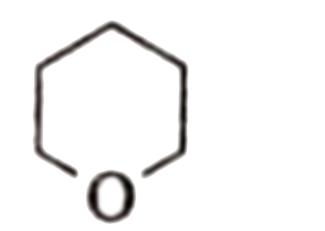In the given reaction ,
X will be

The correct Answer is:D
To solve the given reaction step by step, we will analyze the components involved and the expected reaction mechanism.
Step 1: Identify the Reactants
The reactant is a brominated alcohol, specifically 1-bromo-3-pentanol (Br-CH2-CH2-CH2-CH2-OH). The presence of NaOH indicates that we will have a base-catalyzed reaction.
Hint: Look for the functional groups in the reactant to determine how they might interact with NaOH.
Step 2: Determine the Reaction Mechanism
Since we have a primary alkyl halide (1-bromo-3-pentanol) and a strong base (NaOH), we can initially consider the possibility of an SN2 reaction. However, the presence of the hydroxyl (-OH) group introduces an acidic hydrogen that can be abstracted by the base.
Hint: Remember that primary halides often undergo SN2 reactions, but other factors can influence the outcome.
Step 3: Deprotonation of the Alcohol
The hydroxide ion (OH-) from NaOH will abstract the acidic hydrogen from the hydroxyl group (-OH) of the alcohol. This results in the formation of an alkoxide ion (O-) and the corresponding bromide ion (Br-).
Hint: Identify the acidic hydrogen in the alcohol that can be removed by the base.
Step 4: Formation of the Alkoxide Ion
After deprotonation, we get the alkoxide ion (O-) attached to the carbon chain. The structure can be represented as CH2-CH2-CH2-CH2-O-.
Hint: Visualize the structure of the alkoxide ion formed after deprotonation.
Step 5: Nucleophilic Attack
Now, the alkoxide ion (O-) acts as a nucleophile and attacks the carbon atom bonded to the bromine (Br). This leads to the displacement of the bromine atom, forming a cyclic ether (a five-membered ring) due to the rearrangement of the carbon chain.
Hint: Consider how the nucleophile can attack the electrophilic carbon and what type of product this will yield.
Step 6: Formation of the Product
The product formed is a five-membered cyclic ether, specifically 1,3-dioxane, where the oxygen from the alkoxide forms part of the ring. The final structure will be a cyclic compound with five carbon atoms and one oxygen atom.
Hint: Count the number of atoms in the ring and identify the final product.
Conclusion
The product X formed from the reaction is a five-membered cyclic ether, specifically 1,3-dioxane.
Final Answer: X is 1,3-dioxane.
---
The reactant is a brominated alcohol, specifically 1-bromo-3-pentanol (Br-CH2-CH2-CH2-CH2-OH). The presence of NaOH indicates that we will have a base-catalyzed reaction.
Since we have a primary alkyl halide (1-bromo-3-pentanol) and a strong base (NaOH), we can initially consider the possibility of an SN2 reaction. However, the presence of the hydroxyl (-OH) group introduces an acidic hydrogen that can be abstracted by the base.
The hydroxide ion (OH-) from NaOH will abstract the acidic hydrogen from the hydroxyl group (-OH) of the alcohol. This results in the formation of an alkoxide ion (O-) and the corresponding bromide ion (Br-).
After deprotonation, we get the alkoxide ion (O-) attached to the carbon chain. The structure can be represented as CH2-CH2-CH2-CH2-O-.
Now, the alkoxide ion (O-) acts as a nucleophile and attacks the carbon atom bonded to the bromine (Br). This leads to the displacement of the bromine atom, forming a cyclic ether (a five-membered ring) due to the rearrangement of the carbon chain.
The product formed is a five-membered cyclic ether, specifically 1,3-dioxane, where the oxygen from the alkoxide forms part of the ring. The final structure will be a cyclic compound with five carbon atoms and one oxygen atom.
The product X formed from the reaction is a five-membered cyclic ether, specifically 1,3-dioxane.
Similar Questions
Knowledge Check
What is the major product of the following reaction?
CH3−OH∣CH−CH2−CH2−OHCrO3−−−−−−−→Pyridine coidProductACH3−OH∣CH−CH2−O∣∣C−HBCH3−O∣∣C−CH2−O∣∣C−HCCH3−O∣∣C−CH2−O∣∣C−OHDCH3−OH∣CH−CH2−O∣∣C−OHThe reaction CH2=CH−CH3+HBr→CH3−Br∣CHCH3 is
Anucleophilic additionBfree radical additionCelectrophilic additionDelectrophilic substitutionIn the given reaction:
CH3−OH∣CH−OH∣C∣OH−CH3HiO4−−→(A)+(B)
(A) and (B) respectively be:ACH3CHO and CH3CHOBCH3COCH3 and CH3CHOCCH3COCH3 and CH3COCH3DCH3COOH and CH3COOCH3
In the given reaction
CH3−Br∣CH−CH2−COOHNaOH−−−→(X).
'X' will be
View SolutionIn the given reaction CH3−CH2−Br∣CH−CH=CH2Alc.KOH/Δ−−−−−−−−→(X) X will be
View SolutionThe major product formed in the reaction
CH3CH=CH−O∣∣C−CH3NaBH4−−−−−−−−→H2O,CH3OH is
View SolutionIn the given reaction,
CH3−CH∣CH3−O∣∣C−CH2−CH3CF3CO3H−−−−−→(X)
as main product, 'X' will be
View SolutionIn the given reaction [C6H5−CH2−CH2−⊕N(CH3)2−CH2−CH3]ΘOHΔ−−→ (X) as major product will be
View Solution